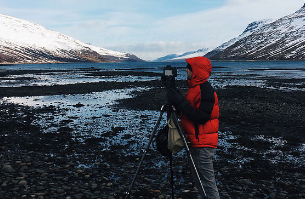• First, check your batteries to make sure they're fully charged. Cold weather drains batteries faster than you'd imagine, especially if you're using live view or checking your shots on your LCD frequently. Carry back-up batteries inside your coat, close to your body, to keep them warm. It's also extremely important to protect your camera and lens. If it's raining or snowing, use ready-made camera/lens covers, but in an emergency improvise with a plastic bag rubber-banded around the camera (leaving an opening for the lens, of course!). Protect the front element of your lens with a filter, such as a daylight or warm bias filter, and pack a cloth in your camera bag, as it's excellent for soaking up moisture if your gear does get wet.
• When you're changing batteries, lenses or flash cards out in the open, make sure your camera is shielded. In fact, try to avoid changing lenses as much as possible, because while doing so you can get moisture inside the camera body, which can freeze and damage it in very cold weather. Instead, plan out what type of shots you want to take and select the best lens accordingly.
• For snowy or frosty scenes, try using the cloudy setting for your white balance, unless you actively want your images to look cold and have a blue cast (in which case change the white balance to daylight). To avoid the camera underexposing because it sees the white scene as too bright, keep an eye on the histogram to see if you're getting a balanced shot. What you want is the bell curve peaking centrally – if it's way over to the left, it indicates underexposure (with a peak far on the right meaning overexposure).
• You can chill down very quickly when you're waiting for the right light to get your shot, so it's vital to keep warm, especially your extremities. Wear a pair of fingerless gloves over a pair of nylon glove liners – this will give you a good feel for making adjustments and pushing buttons. If it's really cold, put on a pair of thermally-lined wool mittens on top of the liners and the gloves. When you're ready to shoot, pull off the mitten, shoot, then put it straight back on. If you're thinking of wearing full gloves instead, take your camera with you when you buy, to check that you can still use it with the gloves on. Use thermally lined boots or hiking boots with layers of thermal socks, and don't forget a warm hat and scarf, plus your thermal undies – layering is the key. And it's better to be too warm than not warm enough, so pack additional warm clothing just in case.
• When you head back indoors, don't bring your camera into the warmth too quickly, as this will make it fog up, and it then takes a while to dry out. Instead, put your camera back in the bag while you're still outside, fasten the bag up then bring it inside, and leave the camera in it for 45-60 minutes before taking it out. This way, the camera warms up gradually inside the cold bag or pack and condensation will be avoided.

